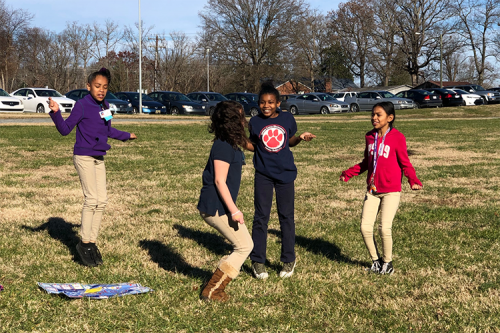Make Outdoor Recess Active
 Even we adults can still remember that feeling of exhilaration when the bell rang to signal the start of recess. We jumped out of our chairs and ran out to the blacktop for 20 or 30 blissful, uninterrupted minutes of fresh air and play.
Even we adults can still remember that feeling of exhilaration when the bell rang to signal the start of recess. We jumped out of our chairs and ran out to the blacktop for 20 or 30 blissful, uninterrupted minutes of fresh air and play.
Recess is a time for kids to release energy and reduce stress, which can also improve attention and reduce disruptive behavior in the classroom. Yet how many times have you seen your kid or his classmates standing around—or even sitting—on the blacktop during recess instead of playing? Kind of defeats the purpose, doesn’t it?
There is a better way. Active recess, also sometimes referred to as structured recess, is a planned and actively supervised recess period where:
- Students engage in organized play or games that emphasize turn-taking, helpfulness, rule following and emotional control.
- Each game or activity has pre-set rules that the whole school follows.
- Older students may be trained to help lead activities for younger students.
The goal is to get all students moving and engaged, and the benefits include reduced bullying, better behavior and easier transitions from recess to learning. What’s not to like, right? Although teachers and administrators may buy into the concept, they may not have the bandwidth to modify their school’s recess program and staff it appropriately on their own.
That’s where you come in. As a parent, you can take the lead in bringing active outdoor recess to your child’s school.
Ways to Get Started
- Review current recess policies and activities with school administration. Ask the following questions:
- Is the school providing the recommended number of minutes for recess?
- Are students active during recess?
- What things are working well?
- What areas need improvement?
- Spruce up the playground! Review and improve recess areas–for example, painting playground surfaces with lines for games such as four square and hopscotch–to encourage active play. Get more ideas on improving play spaces.
- Provide inexpensive playground equipment (e.g. jump ropes, hula hoops, bean bags) to encourage students to be active. If you’re lacking funds for equipment, consider:
- Working with the school to apply for a grant to help support your active recess.
- Getting the community involved to foot the bill. Partner with local businesses to donate new or gently used playground equipment.
- Designate stations or create set areas for activities–for example: a ball bouncing and wall-passing station where wall space is available; a jump rope area; a field game area for soccer, kickball, speedball, flag football, etc.; running/walking on the playground perimeter; a fitness circuit course and/or playground circuit station.
- Actively supervise the playground to minimize injury, encourage active play and ensure safe behavior. When the school holds professional development days, ask if you (or someone else) can get on the agenda to role model and train teachers on how to teach and interact with students to increase physical activity during recess.
- Recruit other parents. Make sure those who volunteer to lead activities and supervise at recess also receive training. Playworks offers trainings and a free online playbook with hundreds of games and activities.
- Encourage older students to role model and support younger students by teaching new activities during recess.
Ways to Reap Recess Rewards
- Choose games with a minimal wait time so students stay engaged and active for as long as possible.
- Be sure recess activities can accommodate all students assigned to a specific recess period. Consider including:
- Activities that require varying levels of skill and ability
- Both competitive and non-competitive options
- Both team and individual games
- Options that don’t require much equipment
- Have students take a pledge to be active during recess, and help them stick with it by tracking their active times throughout the day on a physical activity chart and providing healthy rewards for being active.
- Host a Recess Week in the fall to introduce new activities and boost kids’ enthusiasm for active recess throughout the rest of the school year.
- Encourage activity, but ultimately, give students choices about how to use their free time during recess. (No matter our age, we all like some autonomy.)
Categories: Physical Activity, PE, & Play